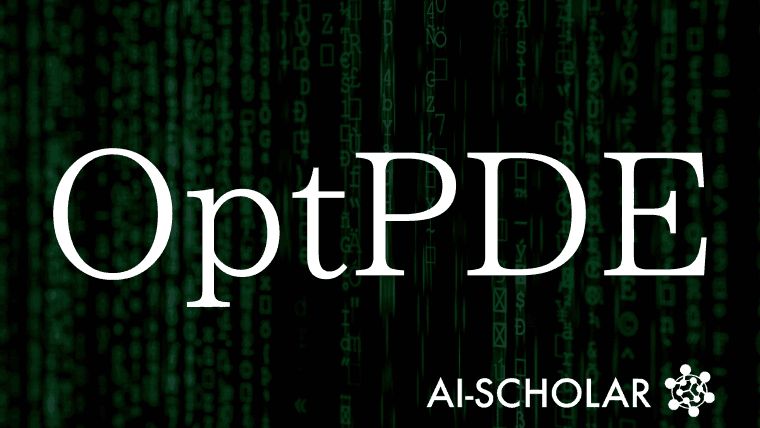
First Machine Learning Method To Automate The Discovery Of Partial Differential Equations (PDEs) For Integrable Systems
3 main points
✔️ OptPDE is a new machine learning method that aims to discover integrable partial differential equations (PDEs) and optimize their coefficients to maximize the number of conserved quantities.
✔️ In this study, four families of PDEs are discovered using OptPDE. Three of them are novel and each has at least one conserved quantity.
✔️ The study establishes a research framework for collaboration between artificial intelligence and human scientists to discover and analyze integrable systems.
OptPDE: Discovering Novel Integrable Systems via AI-Human Collaboration
written by Subhash Kantamneni, Ziming Liu, Max Tegmark
(Submitted on 7 May 2024)
Comments: Published on arxiv.
Subjects: Machine Learning (cs.LG); Computational Physics (physics.comp-ph)
code:
The images used in this article are from the paper, the introductory slides, or were created based on them.
Summary
OptPDE is the first machine learning method to automate the discovery of partial differential equations (PDEs) for integrable systems, with the goal of maximizing the number of conserved quantities by optimizing the PDE coefficients. Integrable systems play an important role in the natural sciences, but they are extremely difficult to discover. To address this problem, the authors propose a new framework in which AI and human scientists work together. This approach makes it possible to discover new integrable systems more efficiently than conventional methods that rely on symbolic derivation.
Related Research
The study of integrable systems has a long history in physics and applied mathematics, but traditional methods require enormous computational resources and expertise, making the discovery of new integrable systems difficult. Recently, machine learning techniques have contributed to solving this problem.
Discovering the Amount of Storage from Physical Data
Past research has attempted to extract physical laws and conserved quantities from experimental physical data using machine learning. For example, studies have used Neural Ordinary Differential Equations (NODEs) to model the dynamics of physical systems and estimate conserved quantities based on these models. These methods are data-driven and can discover important physical properties without knowing the full details of the system a priori.
Conservative Quantity Discovery from Differential Equations
Some methods directly analyze differential equations to find conserved quantities. For example, an approach that uses symbolic regression to search for solution forms of differential equations and derive conserved quantities has been proposed. This makes it possible to mathematically analyze the physical constraints and invariants that the equations hold.
Discovery of Novel Integrable Systems by Conservative Optimization
Prior to OptPDE research, existing machine learning methods did not dynamically adjust the coefficients of differential equations to optimize conserved quantities. Existing methods focused primarily on deriving conserved quantities from analytically or numerically known equations, but OptPDE evolves this approach to actively generate new integrable systems by maximizing the conserved quantities themselves.
AI and Human Collaboration
The latest research accelerates the process of scientific discovery by combining the computational power of AI with human intuition and expertise, and the OptPDE approach takes this collaborative work a step further, clarifying the division of roles whereby AI generates candidate new integrable systems and humans evaluate their physical meaning and accuracy. This is clearly defined.
Given this background and progress, OptPDE is a major advance over conventional methods and is expected to play an important role in future research and applications. New integrable systems will be discovered one after another by this method, and thereby many physical phenomena will be analyzed from new perspectives.
Proposed Method
The core technique of OptPDE is to maximize the number of conserved quantities (nCQ) by adjusting the PDE coefficients. This approach consists of two main steps
Development of CQFinder
Input: A basis is specified for the PDE and the conserved quantity (CQ).
Process: For a given PDE, symbolically derive the conserved quantities and compute their number (nCQ). Conserved quantities are quantities that a PDE should be invariant over time. This step calculates how conserved quantities are constant through time for a given PDE and derives their symbolic form.
Output: Number of storage quantities and their symbolic form.
Execution of OptPDE
Input: Basis for PDE with initial coefficient values.
∙ Process: optimizes the coefficients of the PDE using the output from the CQFinder (nCQ). The process uses automatic differentiation to identify which coefficient perturbations increase nCQ.
Output: PDE with optimized coefficients.
 Figure 1: Schematic of OptPDE
Figure 1: Schematic of OptPDE
Figure 1 provides a visual representation of the OptPDE process. This figure shows the process of optimizing the coefficients of the PDE's basis terms to maximize the number of conserved quantities (nCQ) in the PDE. The illustrated example shows how the conservativeness of the PDE changes before and after the coefficients are first adjusted; OptPDE uses this information to generate a more conservative PDE.
Experiment
OptPDE was tested against a wide range of PDE formats. In particular, performance was verified on common PDEs containing terms up to third-order polynomials.
Experimental Setup
The PDE format was configured without restrictions, resulting in a diverse family of PDEs. This included up to 33 trainable parameters;OptPDEs were run independently on 5000 different parameter sets.
Analysis of Results
The solutions found are represented as four PDE families with at least one conserved quantity.Of the identified PDE families, one is a special case of the known Korteweg-De Vries (KdV) equation and the remaining three are novel.
 Figure 2: Solution Cluster Analysis
Figure 2: Solution Cluster Analysis
In Figure 2, the clusters of solutions returned by OptPDE are shown using 3D PCA. This allows a visual analysis of how the solution structure is distributed in space. This analysis provides insight into how new PDE families were discovered.
In this way, OptPDE enables the discovery of new integrable systems that are often overlooked by conventional methods. This technique can be applied to modeling problems in physics as well as in engineering and other fields.
Conclusion
The collaborative research approach between OptPDE and human scientists shows the potential for significant advances in the discovery and analysis of integrable systems. It is expected that OptPDE will be used to model even more physical phenomena and to analyze new PDE families in the future. This research presents a new paradigm for AI-human collaboration in scientific research and suggests that similar approaches can be applied to other physical problems.
Categories related to this article





![Zero-shot Learning]](https://aisholar.s3.ap-northeast-1.amazonaws.com/media/October2024/arumenoy-tts-520x300.png)
![TIMEX++] Framework F](https://aisholar.s3.ap-northeast-1.amazonaws.com/media/October2024/timex++-520x300.png)

